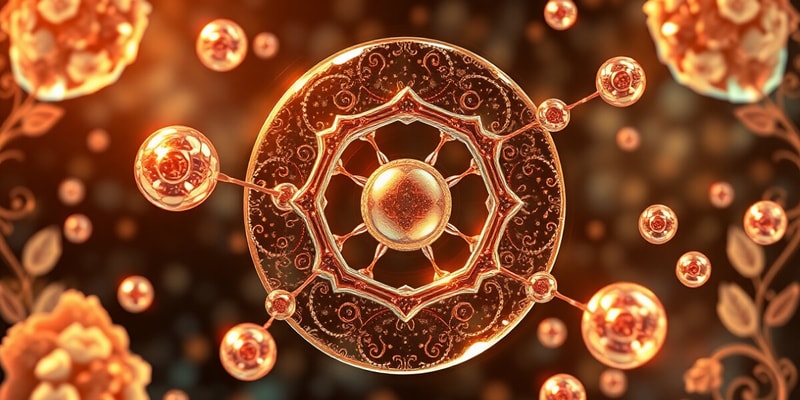Podcast
Questions and Answers
What primarily determines the boiling point of a substance?
What primarily determines the boiling point of a substance?
Why is water's boiling point higher than that of methane?
Why is water's boiling point higher than that of methane?
Which statement best explains the high melting points of ionic compounds?
Which statement best explains the high melting points of ionic compounds?
How do intermolecular forces affect viscosity?
How do intermolecular forces affect viscosity?
Signup and view all the answers
What is the effect of London dispersion forces on boiling points?
What is the effect of London dispersion forces on boiling points?
Signup and view all the answers
What primarily holds atoms together within a molecule?
What primarily holds atoms together within a molecule?
Signup and view all the answers
Which intermolecular force arises from temporary fluctuations in electron distribution?
Which intermolecular force arises from temporary fluctuations in electron distribution?
Signup and view all the answers
What factor is NOT a characteristic that affects the strength of covalent bonds?
What factor is NOT a characteristic that affects the strength of covalent bonds?
Signup and view all the answers
Which of the following correctly describes a hydrogen bond?
Which of the following correctly describes a hydrogen bond?
Signup and view all the answers
Which of the following statements about intermolecular forces is true?
Which of the following statements about intermolecular forces is true?
Signup and view all the answers
What type of bond results from the transfer of electrons between atoms?
What type of bond results from the transfer of electrons between atoms?
Signup and view all the answers
What primarily influences the strength of hydrogen bonds?
What primarily influences the strength of hydrogen bonds?
Signup and view all the answers
How do intramolecular forces compare to intermolecular forces in terms of strength?
How do intramolecular forces compare to intermolecular forces in terms of strength?
Signup and view all the answers
Study Notes
Intermolecular and Intramolecular Forces
- Atoms and molecules are held together by forces, but the strength of these forces varies. The forces holding atoms within a molecule are significantly stronger than the forces between molecules.
Intramolecular Forces
- These forces are the strong bonds that hold atoms together within a molecule.
- The primary intramolecular forces are covalent bonds.
- Covalent bonds result from the sharing of electrons between atoms. This sharing creates a strong electrostatic attraction between the negatively charged electrons and the positively charged nuclei of the atoms.
- The strength of a covalent bond depends on the number of shared electron pairs and the electronegativity difference between the atoms involved.
- Other intramolecular forces include ionic bonds (where electrons are transferred rather than shared), but these are typically not as strong as covalent bonds.
Intermolecular Forces
- These are the weaker forces that act between molecules.
- Intermolecular forces are crucial for determining the physical properties of substances, such as melting point, boiling point, and solubility.
- Intermolecular forces can be broadly classified into several types, each with its own unique characteristics.
- Dipole-dipole forces: These forces arise from the electrostatic attraction between the positive and negative ends of polar molecules. Polarity is caused by differences in electronegativity between atoms within a molecule.
- London dispersion forces (or van der Waals forces): These are the weakest intermolecular forces and are present in all molecules, regardless of polarity. These forces arise from temporary fluctuations in electron distribution around atoms, creating temporary dipoles. The greater the number of electrons in a molecule, the stronger the London dispersion forces.
- Hydrogen bonds: These are relatively strong intermolecular forces that occur between a hydrogen atom bonded to a highly electronegative atom (like oxygen, nitrogen, or fluorine) and another electronegative atom in a different molecule. The hydrogen is partially positive and forms a strong attraction to a lone pair on the neighboring electronegative atom. Hydrogen bonds are significant because they account for the anomalous properties of water.
Relative Strengths
- Intramolecular forces (covalent bonds) are substantially stronger than intermolecular forces. This explains why it takes a lot more energy to break a molecule into its constituent atoms than to separate molecules from each other.
- The strength of intermolecular forces is directly related to the physical properties of matter such as boiling point, melting point, viscosity, and surface tension. Stronger intermolecular forces result in higher boiling and melting points, greater viscosity, and higher surface tension.
Examples
- Water's high boiling point, compared to other molecules of similar molar mass, is a direct consequence of the strong hydrogen bonds between water molecules.
- The relatively low boiling point of methane, a nonpolar molecule, is due to the much weaker London dispersion forces between its molecules.
- The relatively high melting points of ionic compounds are because of the strong electrostatic attractions between the ions in the crystal lattice.
Studying That Suits You
Use AI to generate personalized quizzes and flashcards to suit your learning preferences.
Description
Explore the differences between intermolecular and intramolecular forces in this quiz. Understand how atoms and molecules interact, focusing on the strength and types of bonds that hold them together. Test your knowledge on covalent and ionic bonds as well as the nature of molecular forces.




